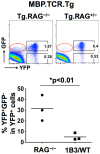Peripherally induced tregs - role in immune homeostasis and autoimmunity
- PMID: 23966994
- PMCID: PMC3736167
- DOI: 10.3389/fimmu.2013.00232
Peripherally induced tregs - role in immune homeostasis and autoimmunity
Abstract
Thymically derived Foxp3(+) regulatory T cells (tTregs) constitute a unique T cell lineage that is essential for maintaining immune tolerance to self and immune homeostasis. However, Foxp3 can also be turned on in conventional T cells as a consequence of antigen exposure in the periphery, under both non-inflammatory and inflammatory conditions. These so-called peripheral Tregs (pTregs) participate in the control of immunity at sites of inflammation, especially at the mucosal surfaces. Although numerous studies have assessed in vitro generated Tregs (termed induced or iTregs), these cells most often do not recapitulate the functional or phenotypic characteristics of in vivo generated pTregs. Thus, there are still many unanswered questions regarding the T cell receptor (TCR) repertoire and function of pTregs as well as conditions under which they are generated in vivo, and the degree to which these characteristics identify specialized features of pTregs versus features that are shared with tTregs. In this review, we summarize the current state of our understanding of pTregs and their relationship to the tTreg subset. We describe the recent discovery of unique cell surface markers and transcription factors (including Neuropilin-1 and Helios) that can be used to distinguish tTreg and pTreg subsets in vivo. Additionally, we discuss how the improved ability to distinguish these subsets provided new insights into the biology of tTregs versus pTregs and suggested differences in their function and TCR repertoire, consistent with a unique role of pTregs in certain inflammatory settings. Finally, these recent advances will be used to speculate on the role of individual Treg subsets in both tolerance and autoimmunity.
Keywords: Helios; autoimmunity; immune tolerance; neuropilin-1; regulatory T cell.
Figures



References
Grants and funding
LinkOut - more resources
Full Text Sources
Other Literature Sources
Medical

